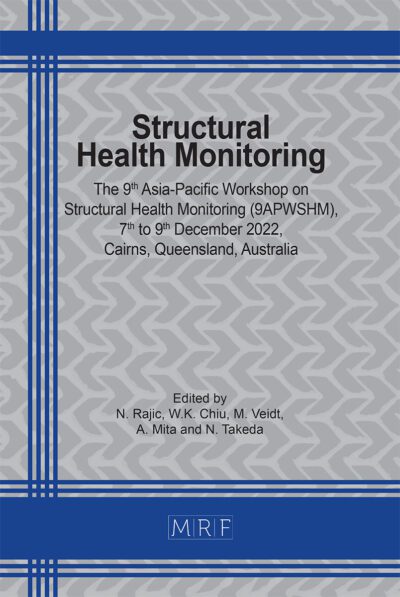FSW process mechanics and resulting properties for dissimilar Al-Ti T-joints
RANA Harikrishna, BUFFA Gianluca, FRATINI Livan
download PDFAbstract. Emergent manufacturing demands for superior performance but lightweight structures have pinpointed the development of multi-material and hybrid structures specifically in the aerospace and automotive industrial sectors. Friction stir welding (FSW), a solid-state joining technique has been proven very effective to produce joints between materials possessing extremely diverse thermal and mechanical properties. The present research aims to investigate the feasibility of Al-Ti skin-stringer joints with different plate geometries and placements. The effect of different approaches on material flow, grain morphology, intermittent phases, joint resistance, and microhardness are discussed in depth.
Keywords
FSW, T-Joint, Dissimilar, Skin, Stringer, Titanium, Aluminum, Material Flow
Published online 4/19/2023, 10 pages
Copyright © 2023 by the author(s)
Published under license by Materials Research Forum LLC., Millersville PA, USA
Citation: RANA Harikrishna, BUFFA Gianluca, FRATINI Livan, FSW process mechanics and resulting properties for dissimilar Al-Ti T-joints, Materials Research Proceedings, Vol. 28, pp 1091-1100, 2023
DOI: https://doi.org/10.21741/9781644902479-120
The article was published as article 120 of the book Material Forming
![]() Content from this work may be used under the terms of the Creative Commons Attribution 3.0 license. Any further distribution of this work must maintain attribution to the author(s) and the title of the work, journal citation and DOI.
Content from this work may be used under the terms of the Creative Commons Attribution 3.0 license. Any further distribution of this work must maintain attribution to the author(s) and the title of the work, journal citation and DOI.
References
[1] W. Vaidya, M. Horstmann, V. Ventzke, B. Petrovski, M. Koçak, R. Kocik, G. Tempus, Improving interfacial properties of a laser beam welded dissimilar joint of aluminium AA6056 and titanium Ti6Al4V for aeronautical applications, J. Mater. Sci. 45 (2010) 6242-6254. https://doi.org/10.1007/s10853-010-4719-6
[2] W. Shouzheng, L. Yajiang, W. Juan, L. Kun, Research on cracking initiation and propagation near Ti/Al interface during TIG welding of titanium to aluminum, Kovove Mater. 52 (2014) 85-91. https://doi.org/10.4149/km2014285
[3] P. Patel, H. Rana, V. Badheka, V. Patel, W. Li, Effect of active heating and cooling on microstructure and mechanical properties of friction stir–welded dissimilar aluminium alloy and titanium butt joints, Weld World 64 (2020) 365-378. https://doi.org/10.1007/s40194-019-00838-6
[4] Y.-C. Kim, A. Fuji, Factors dominating joint characteristics in Ti–Al friction welds, Sci. Technol. Weld. Join. 7 (2002) 149-154.
[5] L. Fratini, G. Buffa, L.L. Monaco, Improved FE model for simulation of friction stir welding of different materials, Sci. Technol. Weld. Join. 15(3) (2010) 199-207.
[6] A. Simar, M.-N. Avettand-Fènoël, State of the art about dissimilar metal friction stir welding, Sci. Technol. Weld. Join. 22(5) (2017) 389-403. https://doi.org/10.1080/13621718.2016.1251712
[7] H. Rostami, S. Nourouzi, H.J. Aval, Analysis of welding parameters effects on microstructural and mechanical properties of Ti6Al4V and AA5052 dissimilar joint, J. Mech. Sci 32 (2018) 3371-3377. https://doi.org/10.1007/s12206-018-0640-8
[8] B. Li, Z. Zhang, Y. Shen, W. Hu, L. Luo, Dissimilar friction stir welding of Ti–6Al–4V alloy and aluminum alloy employing a modified butt joint configuration: Influences of process variables on the weld interfaces and tensile properties, Mater. Des 53 (2014) 838-848. https://doi.org/10.1016/j.matdes.2013.07.019
[9] A. Kar, S. Suwas, S.V. Kailas, Multi-length scale characterization of microstructure evolution and its consequence on mechanical properties in dissimilar friction stir welding of titanium to aluminum, Metall. Mater. Trans. A 50 (2019) 5153-5173.
[10] Z. Ma, X. Sun, S. Ji, Y. Wang, Y. Yue, Influences of ultrasonic on friction stir welding of Al/Ti dissimilar alloys under different welding conditions, Int. J. Adv. Manuf. Technol. 112 (2021) 2573-2582. https://doi.org/10.1007/s00170-020-06481-6
[11] A. Kar, S.K. Choudhury, S. Suwas, S.V. Kailas, Effect of niobium interlayer in dissimilar friction stir welding of aluminum to titanium, Mater. Charact. 145 (2018) 402-412. https://doi.org/10.1016/j.matchar.2018.09.007
[12] H. Rana, D. Campanella, G. Buffa, L. Fratini, Dissimilar titanium-aluminum skin-stringer joints by FSW: process mechanics and performance, Mater. Manuf. Process. 38 (2023) 471-484. https://doi.org/10.1080/10426914.2022.2116044
[13] Y. Chen, C. Liu, G. Liu, Study on the joining of titanium and aluminum dissimilar alloys by friction stir welding, Open Mater. Sci. 5 (2011). https://doi.org/10.2174/1874088X01105010256
[14] Y. Su, W. Li, F. Gao, A. Vairis, Effect of FSW process on anisotropic of titanium alloy T-joint, Mater. Manuf. Process. 37 (2022) 25-33. https://doi.org/10.1080/10426914.2021.1942911
[15] H. Rana, V. Badheka, A. Kumar, A. Satyaprasad, Strategical parametric investigation on manufacturing of Al–Mg–Zn–Cu alloy surface composites using FSP, Mater. Manuf. Process. 33 (2018) 534-545. https://doi.org/10.1080/10426914.2017.1364752
[16] E. Lertora, C. Mandolfino, C. Gambaro, Effect of welding parameters on AA8090 Al-Li alloy FSW T-joints, Key Eng. Mater. 554c(2013) 985-995. https://doi.org/10.4028/www.scientific.net/KEM.554-557.985













